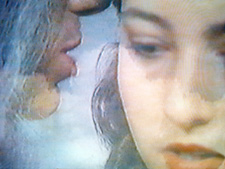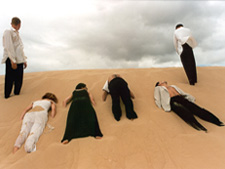Rodrigo Alonso
 |
|
 |
| Silvina Szperling. Bilingual Duetto (for Screen and Life). Video. 1994. |
 |
Margarita Bali. Arena. Video. 1998. |
 |
Dating from 1993, but with multiple precedents which relate it to the experimental work of pioneer choreographers of the sixties, Argentine video dance has achieved, in only five years, the gene-ration of its own space within the circuit of contemporary audiovisual productions.
One of the key factors in establishing this legitimacy was the creation of the Festival lnternacional de Video Danza de Buenos Aires in 1995. This event came to fill a space reclaimed by the production which had timidly started to appear in some alternative fields. Since then, the festival has become an essential meeting for national production and one of the main ways of access for this production to similar events abroad.
The continuity of this space has determined, up to a point, the continuity of the production and of some creators set on frequenting its screens. But there are also some productions outside the festival which consolidate and widen the circuit, particularly with reference to multimedia dance which, in the last few years, has started to be strongly perceived.
One of the most prolific creators committed to the research of the limits between dance and the audiovisual universe is Margarita Bali. Since her first multimedia work. LÍnea de Fuga (1994) -which incorporated the pieces Paula en Suspenso (1993), Asalto al Patio (1994) and Dos en la Cornisa (1994)- until now, her production has been increasingly growing. In 1994, Asalto al Patio won an award in the Buenos Aires Video show -the most prestigious video art exhibition of our country- while her most recent production, Arena (1998), was distinguished by one of the main awards in the same competition.
Arena belongs to a series started the previous year with Agua (1997) in which the landscape occupies a place together with the protagonists. The pieces show continuous conflicts between the dancers and the omnipotence/omnipresence of nature (a translation of the conflict between dancers and scenographic elements which characterizes the choreography of the artist); the work of choreography become writing on the natural landscape. In this productions, Bali diminishes the importance of the effects of editing, so dear to her previous works, such as Asalto al Patio and Dos en la Cornisa. Moreover, she emphasizes the relationships of the dancers with their enviroment through the settings and the relationship between the choreographic phrases produced throughout the visual sequencing.
Margarita Bali had participated in the Video Dance Workshop for Choreographers delivered by filmmaker Jorge Coscia in 1993, which formely inaugurated the genre in our country. That same workshop gave birth to the first works by Silvina Szperling and Paula De Luque, two creators of great prominence in the local video dance circuit.
Temblor (1993) by Silvina Szperling -made up in the aforementioned workshop- is one of the first works in which the references to a pre-existing choreography are clearly diluted. All the dance emerges in the editing based on sectored corporeal movements, inaccessible from the seat of the viewer attending a traditional performance of dance. In contrast with the creations by Margarita Bali, where general shots capturing the relationships between the dancers and their enviroment predominate, Temblor is based on close-ups which generate a space of great intimacy, in accordance with the nudity of the performing bodies and the feminine universe that Szperling wishes to represent.
Paula De Luque, on the other hand, works with preexistent choreographies that she deconstructs during shooting or postproduction. Some of her works have a cinematographic appearance, such as EI otro espejo (1995), some others are clearly videographic such as EI Territorio (1996). In both cases, the organization of images enhances the underlying dramatic conflict in the short choreographic duets that feature them through a very scrupulous control of composition and editing.
The tendency towards the cinematographic treatment of the image, common in other parts of the world, is quite scarce in Argentine production. Clearly narrative works such as Espectros (1995) by Ariel Rotter or works based on dramatic situations such as Lo que dice la noche (1998) by Laura Zenobi, Carolina Chaves, Graciela Devesa and Mónica Ross are exceptional.
Rather more common is the tendency towards plastic visual treatment such as in the case of Danzagrafía (1996) by Julio Lascano or La dote (1997) by Mario Chierico. But the most outstanding representative of this tendency is videomaker Jorge Castro.
Castro departs from the recording of choreographic pieces but with the clear aim of achieving an audiovisual composition in which dance does not occupy a higher place in the hierarchy of sound and visual elements. In his work, the screen is the surface where the electronic recording meets the infinite possibilities of electronic or digital editing. The rhythm, the colour, the formal research and the solid structure which gives cohesion to the hole, stands out. Tabla esmeralda (1995), one of his most successful creations, is the visualization of a cyclical universe generated from a dance based on circular movements. Recently, with the incorporation of digital technology, his works are seeking to scape from the effects pre-established by the available software through complex combinations of them. From this research line emerged RES (Rastros-espiritu-sedimento) (1998) and Albedo: la triple vía del fuego (1998).
In the last few years, the number of multimedia pieces has notably increased occupying more important spaces. Margarita Bali and Susana Szperling are the main promoters of this kind of performance, Sabrina Farji and Mariana Bellotto, after having won the first award of the Segundo Festival Internacional de Video Danza de Buenos Aires with the multimedia work Girones (1996), took a step forward in multimedia research when creating a video dance for Internet, Danza binaria (1997), in which the segments of a fragmented choreography can be recomposed by the visitor of a web site through a use of a mouse.
The aim of avoiding the traditional spaces for dance and its pre-established forms of enjoyment, the possibility of generating a composition of movements from images which move themselves. the research into a means which allows choreographic creation a wider diffusion, the confrontation between a kinetic language and another one ruled by a different logic and the attempt to enhance a choreographic creation with a choreography of the look which captures it or through the visual and sound treatment outside the performance field, were the main engines for the birth and development of video dance in our country. Its achievements originated a renewed impulse even in the scenic production which day after day incorporates the aesthetic approaches generated by the contemporary audiovisual universe.
Digital technology is introducing new chalenges into creation, expanding to unimaginable levels the possibilities of editing, putting at the disposal of the choreographer a universe of images of synthesis and of virtual spaces for their composition almost ad infinitum or compelling them to once again rethink their language in accordance with a renewed audiovisual grammar. The first productions are reaching the theatres, the screens and the computers. We only have to wait and renew -we too- our capacity of amazement.
|
Published in:
VII Mostra de Vídeo Dansa (cat). Barcelona: Centre d’Art Santa Mónica. 1999.
|

